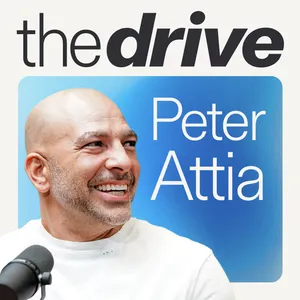#376 - AMA #78: Longevity interventions, exercise, diagnostic screening, and managing high apoB, hypertension, metabolic health, and more
The Peter Attia Drive
View the Show Notes Page for This Episode
Become a Member to Receive Exclusive Content
Sign Up to Receive Peter's Weekly Newsletter
In this "Ask Me Anything" (AMA) episode, Peter tackles a wide-ranging set of listener questions spanning lifespan interventions, exercise, cardiovascular risk reduction, time-restricted eating, blood pressure management, hormone therapy, diagnostics, and more. Peter reveals the single most important lever for extending healthspan and lifespan, and explains how he motivates midlife patients using the Centenarian Decathlon framework. He discusses the importance of addressing high apoB and cholesterol even in metabolically healthy individuals with calcium scores of zero, how to manage high blood pressure, and how to accurately evaluate metabolic health beyond HbA1c. Additional topics include time-restricted eating, practical considerations around ultra-processed foods, nuanced approaches to HRT for women and TRT for men, and why early and expanded screening for chronic disease—colonoscopy, PSA, coronary imaging, low-dose CT—can be lifesaving. He also offers insights into treating prediabetes, crafting exercise programs for those short on time, and safely incorporating high-intensity training in older adults.
If you're not a subscriber and are listening on a podcast player, you'll only be able to hear a preview of the AMA. If you're a subscriber, you can now listen to this full episode on your private RSS feed or our website at the AMA #78 show notes page. If you are not a subscriber, you can learn more about the subscriber benefits here.
We discuss:
Introducing a wide-ranging AMA: practical perspectives on lifespan interventions, metabolic health, diet, hormones, diagnostics, and more [2:45];
Why exercise is the most powerful single intervention for lifespan and healthspan [4:15];
How Peter motivates midlife patients to prioritize exercise [6:00];
Why lifespan and healthspan should not be treated as competing priorities and how choosing sustainable interventions benefits both [9:30];
Why high apoB deserves treatment even in a metabolically healthy patient with a CAC score of zero [14:00];
Managing hypertension: ideal targets for blood pressure, lifestyle levers, and why early pharmacology matters [18:15];
Assessing metabolic health beyond HbA1c: fasting insulin, triglycerides, lactate, zone 2, and more [23:30];
How to avoid common self-sabotaging patterns by choosing sustainable habits over extreme health interventions [26:00];
Time-restricted eating: minimal effect beyond calorie control, implications for protein intake, and practical considerations for implementing it [28:00];
Ultra-processed foods: definitions, real-world risks, and practical guidelines for smarter consumption [30:30];
How women should prepare for menopause and think about hormone replacement therapy: early planning, symptom awareness, and guidance on HRT [36:45];
Testosterone replacement for aging men: indications, benefits, and safe clinical management [39:45];
Why Peter recommends earlier and more aggressive screening tests than guidelines suggest: colonoscopies, coronary imaging, PSA, Lp(a), and low-dose CT scans, and more [43:30];
Full-body MRI screening: benefits, limitations, potential false positives, and the importance of physician oversight [47:15];
Prediabetes: individualized treatment strategies using tailored combinations of nutrition, sleep, and training interventions [51:00];
Time-efficient training plans for people with only 30 minutes per day to exercise [53:00];
How to safely introduce high-intensity exercise for older adults [55:00];
Timed dead hangs and ripping phone books: a playful look at Peter's early attempts to impress his wife [57:15];
Peter's carve out: The Four Kings documentary about a golden era of boxing [1:01:15]; and
More.
Connect With Peter on Twitter, Instagram, Facebook and YouTube








